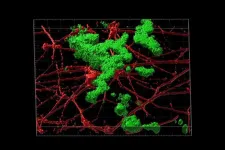(Press-News.org) Researchers at Washington University School of Medicine in St. Louis have developed a way to capture the effects of aging in the development of Alzheimer’s disease. They have devised a method to study aged neurons in the lab without a brain biopsy, an advancement that could contribute to a better understanding of the disease and new treatment strategies.
The scientists transformed skin cells taken from patients with late-onset Alzheimer’s disease into brain cells called neurons. Late-onset Alzheimer’s develops gradually over many decades and only starts to show symptoms at age 65 or older. For the first time, these lab-derived neurons accurately reproduced the hallmarks of this type of dementia, including the amyloid beta buildup, tau protein deposits and neuronal cell death.
By studying these cells, the researchers identified aspects of cells’ genomes — called retrotransposable elements, which change their activity as we age — in the development of late-onset Alzheimer’s disease. The findings suggest new treatment strategies targeting these factors.
The study appears Aug. 2 in the journal Science.
“Sporadic, late-onset Alzheimer’s disease is the most common type of Alzheimer’s disease, representing more than 95% of cases,” said senior author Andrew Yoo, PhD, a professor of developmental biology. “It has been very difficult to study in the lab due to the complexity of the disease stemming from various risk factors, including aging as an important contributor. Until now, we did not have a way to capture the effects of aging in the cells to study late-onset Alzheimer’s.”
To date, animal studies of Alzheimer’s disease have, by necessity, focused on mice with rare genetic mutations known to cause inherited, early-onset Alzheimer’s in younger people — a strategy that has shed light on the condition but differs from disease development for the vast majority of patients with the sporadic, late-onset form. To more faithfully recapitulate the disease in the lab, Yoo’s team turned to an approach called cellular reprogramming.
The method to transform easily obtained human skin cells from living patients directly into neurons makes it possible to study Alzheimer’s effects on the brain without the risk of a brain biopsy and in a way that retains the consequences of the patient’s age on the neurons. Past work by Yoo and his colleagues, who pioneered this transformation technique using small RNA molecules called microRNAs, has focused on understanding the development of Huntington’s disease — an inherited neurological condition that typically shows adult-onset symptoms.
After transforming skin cells into brain cells, the researchers found that the new neurons can grow in a thin gel layer or self-assemble into small clusters — called spheroids — mimicking the 3D environment of the brain. The researchers compared neuronal spheroids generated from patients with sporadic, late-onset Alzheimer’s disease, inherited Alzheimer’s disease and healthy individuals of similar ages.
The Alzheimer’s disease patients’ spheroids quickly developed amyloid beta deposits and tau tangles between neurons. Activation of genes associated with inflammation also emerged, and then the neurons began to die, mimicking what is seen in brain scans of patients. Spheroids from older, healthy donors in the study showed some amyloid deposition but much less than those from patients. The small amyloid deposits in older, healthy spheroids are evidence that the technique is capturing the effects of age and suggest that amyloid beta and tau accumulation correlated with aging. It further demonstrates that the Alzheimer’s disease process makes the buildup far worse.
The researchers, including first author Zhao Sun, PhD, a staff scientist in Yoo’s lab, found that treating spheroids from late-onset Alzheimer’s disease patients with drugs that interfere with the formation of amyloid beta plaques early in the disease process, before neurons start forming toxic amyloid beta buildup, significantly reduced the amyloid beta deposits. But treating at later time points, after some buildup was already present, had no effect or only modestly reduced subsequent amyloid beta deposits. Such data emphasize the importance of identifying and treating the disease early.
The study further found a role for retrotransposable elements — small pieces of DNA that jump to different locations in the genome — in the development of late-onset Alzheimer’s disease. Inhibition of such “jumping genes” with the drug lamivudine (also called 3TC) — an anti-retroviral drug that can dampen the activity of retrotransposable elements — had a positive effect: The spheroids from late-onset Alzheimer’s disease patients had reduced amyloid beta and tau tangles and showed less neuronal death compared with the same spheroids treated with a placebo. Lamivudine treatment had no beneficial effect on spheroids from patients with early-onset, inherited Alzheimer’s disease, providing evidence that sporadic late-onset Alzheimer’s development related to aging has distinct molecular features compared with inherited autosomal dominant Alzheimer’s disease.
“In these patients, our new model system has identified a role for retrotransposable elements associated with the disease process,” Yoo said. “We were pleased to see that we could reduce the damage with a drug treatment that suppresses these elements. We look forward to using this model system as we work toward new personalized therapeutic interventions for late-onset Alzheimer’s disease.”
The researchers are planning future studies with spheroids that include multiple types of brain cells, including neurons and glia.
END
Aging-related genomic culprit found in Alzheimer’s disease
With new technique, patient-derived neurons accurately model late-onset Alzheimer’s, point to potential treatments
2024-08-01
ELSE PRESS RELEASES FROM THIS DATE:
Andean glaciers have retreated to lowest levels in 11,700 years, news study finds
2024-08-01
Chestnut Hill, Mass (8/1/2024) – Rocks recently exposed to the sky after being covered with prehistoric ice show that tropical glaciers have shrunk to their smallest size in more than 11,700 years, revealing the tropics have already warmed past limits last seen earlier in the Holocene age, researchers from Boston College report today in the journal Science.
Scientists have predicted glaciers would melt, or retreat, as temperatures warm in the tropics – those regions bordering the Earth’s ...
States consider new science-backed solution to save time and money on concrete infrastructure repair
2024-08-01
WEST LAFAYETTE, Ind. — A Purdue University invention that may shorten construction timelines and increase long-term durability of concrete highways, bridges and other transportation infrastructure is emerging as a viable alternative to methods that have been used for decades to estimate when newly poured concrete is mature enough to withstand heavy loads such as those from trucks and other vehicles.
The American Association of State Highway and Transportation Officials’ Committee on Materials and Pavements (AASHTO COMP) has approved the Purdue-developed method as a new national ...
New England Journal of Medicine letter shows plant protein beats animal protein
2024-08-01
BOSTON—Plant-based proteins have major health advantages over animal-based proteins, according to a New England Journal of Medicine letter to the editor by Neal D. Barnard, MD, published Aug. 1, 2024. New findings show that all plants contain all essential amino acids, in contrast to the common but mistaken belief that plants lack one or more amino acids. Of the 20 amino acids that are the building blocks of protein, nine cannot be produced by the human body. All are found in plant sources.
“In addition, plant-based ...
August issues of APA journals cover new research on PTSD, suicide, personal recovery, eating disorders, and more
2024-08-01
WASHINGTON, D.C., Aug. 1, 2024 — The latest issues of three American Psychiatric Association journals, The American Journal of Psychiatry, Psychiatric Services, and Focus are now available online.
The August issue of The American Journal of Psychiatry brings together research on PTSD, phobias, suicide attempts, and psychiatric vulnerabilities. Highlights include:
Neurobiology and Treatment of Posttraumatic Stress Disorder.
Testing Quantitative and Qualitative Sex Effects in a National Swedish Twin-Sibling Study of Posttraumatic Stress Disorder.
Sexual Identity Continuity and Change in a U.S. National Probability Sample of Sexual Minority Adults: Associations ...
Angel Martí elected fellow of the American Chemical Society
2024-08-01
By Jade Boyd
Special to Rice News
Rice University’s Angel Martí has been elected a fellow of the American Chemical Society (ACS), one of his discipline’s highest honors.
Martí, professor and department chair of chemistry, is among 37 newly elected fellows announced by ACS this week. With more than 200,000 members in 140 countries, ACS is one of the largest scientific organizations. Fewer than 1% of its members are fellows, a distinction reserved for those with exemplary records of both service to the society and outstanding scientific or professional achievement.
Martí joined ...
Rice, DOE labs tackle knowledge gap in materials science research
2024-08-01
HOUSTON – (August 1, 2024) – Materials behave differently in different size regimes, and researchers tend to cluster their efforts either at the nanoscale, examining materials in atom-level detail, or at the microscale, looking at structures between three and five orders of magnitude greater.
However, less is known about what happens in the “in-between” realm spanning from 10 billionths to 1 millionth of a meter.
“We call this the mesoscale,” said Rice University materials scientist Lane Martin, who together with collaborators at the U.S. Department of Energy’s (DOE) Argonne National Laboratory and Lawrence Berkeley National ...
ACM publishes first issue of Proceedings of the ACM on Software Engineering
2024-08-01
ACM, the Association for Computing Machinery, has recently published the first issue of Proceedings of the ACM on Software Engineering (PACSME), a new Gold Open Access journal publishing top-quality, original research on all aspects of software engineering, from requirements elicitation to quality assessment, design, maintenance, evolution, and deployment. PACMSE covers a broad range of topics and methods that help conceive, create, and maintain better software be it embedded, cloud-based, mobile and ubiquitous, or runs on conventional computers.
“The overarching goal of the new PACSME journal is to make ...
Barriers complicate exercise for disability community
2024-08-01
An estimated 16% of people worldwide live with a significant disability that impacts their daily life. Of this population, only about 40% engage in aerobic activity. Due to this lack of exercise, people with disabilities (PWD) are more likely to suffer from chronic conditions such as heart disease, stroke, diabetes, or cancer and are at higher risk of mental illnesses like depression and anxiety.
“Many PWD struggle with psychological issues such as low self-esteem and negative body image, which can further reduce their motivation to participate in exercise activities, especially in public places ...
Venezuelan crisis has negatively affected country’s Internet
2024-08-01
As the Venezuelan crisis intensifies, researchers and policy experts have worked to understand its ramifications on the country’s politics, economics, health services, water security, infrastructure and more.
Now, Northwestern University computer scientists have comprehensively examined the effects of the crisis on a previously unexplored area: the Internet.
In a new study, the researchers found the crisis has significantly — and negatively — affected Venezuela’s Internet infrastructure and connectivity. Compared to the ...
COSPAR 2024: Embracing team spirit in space research
2024-08-01
The Committee on Space Research (COSPAR) has successfully concluded its 45th COSPAR Scientific Assembly in Busan, Korea, held from 13 to 21 July. This prestigious event brought together more than 3,000 experts and leaders from 55 countries in all major fields of space science, under the theme “Team Spirit in Space Research”. This biennial event, actively supported by major space organizations, is a benchmark for fostering dialogue and collaboration within the global space science community.
Bringing space leaders together
Of particular note this time was the showcasing of ...
LAST 30 PRESS RELEASES:
Estimating unemployment rates with social media data
Climate policies can backfire by eroding “green” values, study finds
Too much screen time too soon? A*STAR study links infant screen exposure to brain changes and teen anxiety
Global psychiatry mourns Professor Dan Stein, visionary who transformed mental health science across Africa and beyond
KIST develops eco-friendly palladium recovery technology to safeguard resource security
Statins significantly reduce mortality risk for adults with diabetes, regardless of cardiovascular risk
Brain immune cells may drive more damage in females than males with Alzheimer’s
Evidence-based recommendations empower clinicians to manage epilepsy in pregnancy
Fungus turns bark beetles’ defenses against them
There are new antivirals being tested for herpesviruses. Scientists now know how they work
CDI scientist, colleagues author review of global burden of fungus Candida auris
How does stroke influence speech comprehension?
B cells transiently unlock their plasticity, risking lymphoma development
Advanced AI dodel predicts spoken language outcomes in deaf children after cochlear implants
Multimodal imaging-based cerebral blood flow prediction model development in simulated microgravity
Accelerated streaming subgraph matching framework is faster, more robust, and scalable
Gestational diabetes rose every year in the US since 2016
OHSU researchers find breast cancer drug boosts leukemia treatment
Fear and medical misinformation regarding risk of progression or recurrence among patients with breast cancer
Glucagonlike peptide-1 receptor agonists and asthma risk in adolescents with obesity
Reviving dormant immunity: Millimeter waves reprogram the immunosuppressive microenvironment to potentiate immunotherapy without obvious side effects
Safety decision-making for autonomous vehicles integrating passenger physiological states by fNIRS
Fires could emit more air pollution than previously estimated
A new way to map how cells choose their fate
Numbers in our sights affect how we perceive space
SIMJ announces global collaborative book project in commemoration of its 75th anniversary
Air pollution exposure and birth weight
Obstructive sleep apnea risk and mental health conditions among older adults
How talking slows eye movements behind the wheel
The Ceramic Society of Japan’s Oxoate Ceramics Research Association launches new international book project
[Press-News.org] Aging-related genomic culprit found in Alzheimer’s diseaseWith new technique, patient-derived neurons accurately model late-onset Alzheimer’s, point to potential treatments








